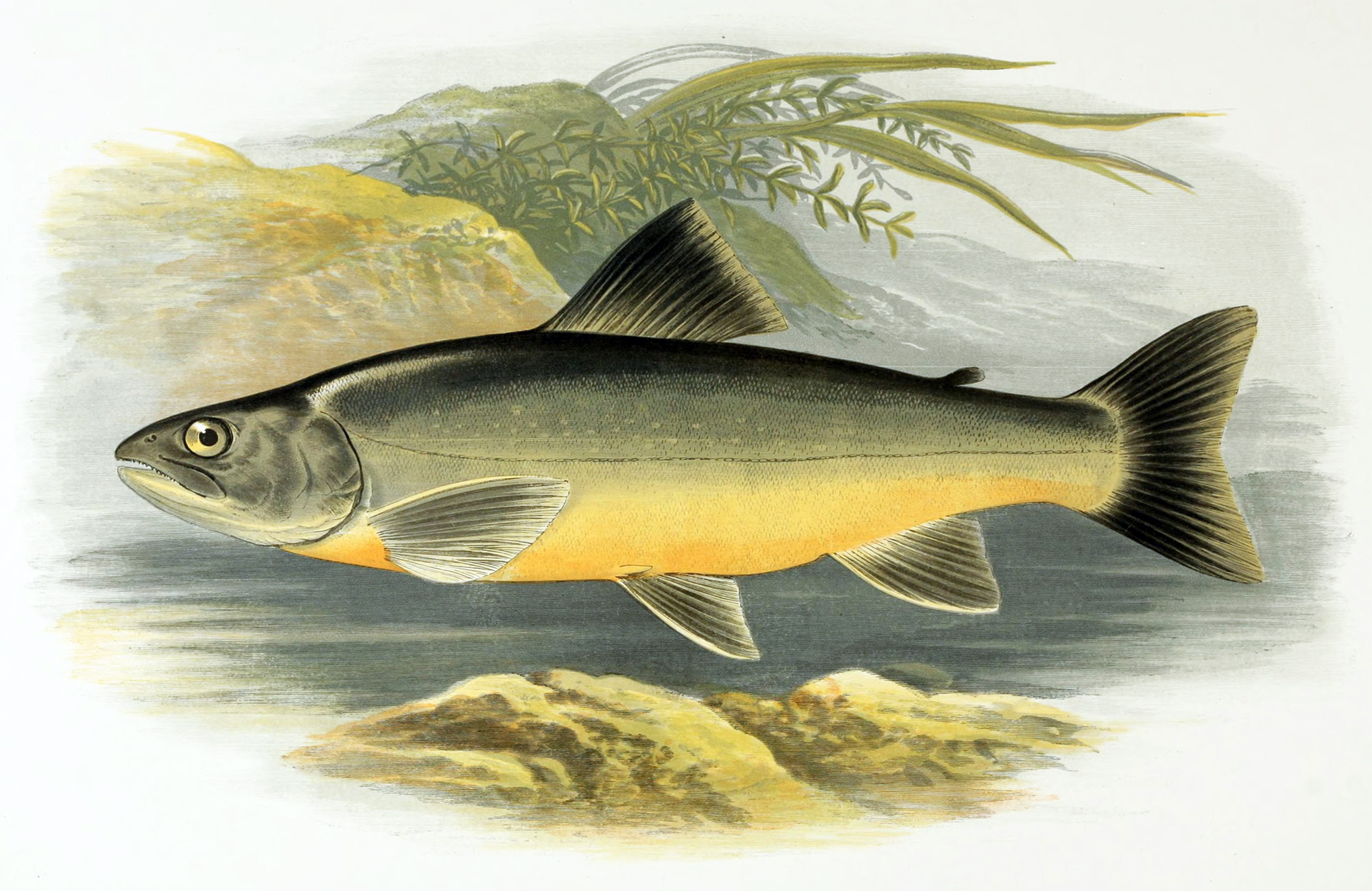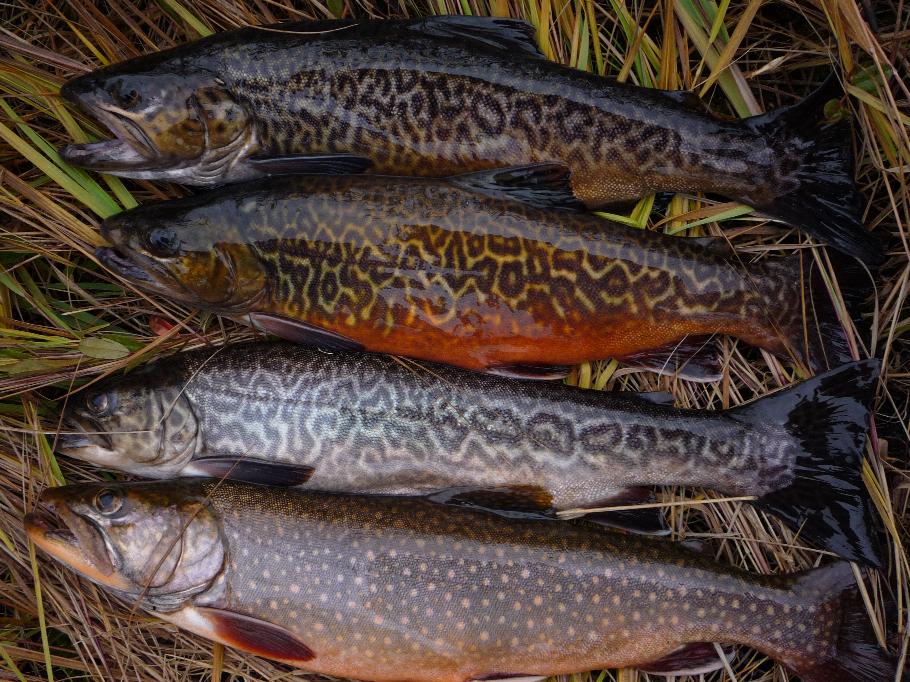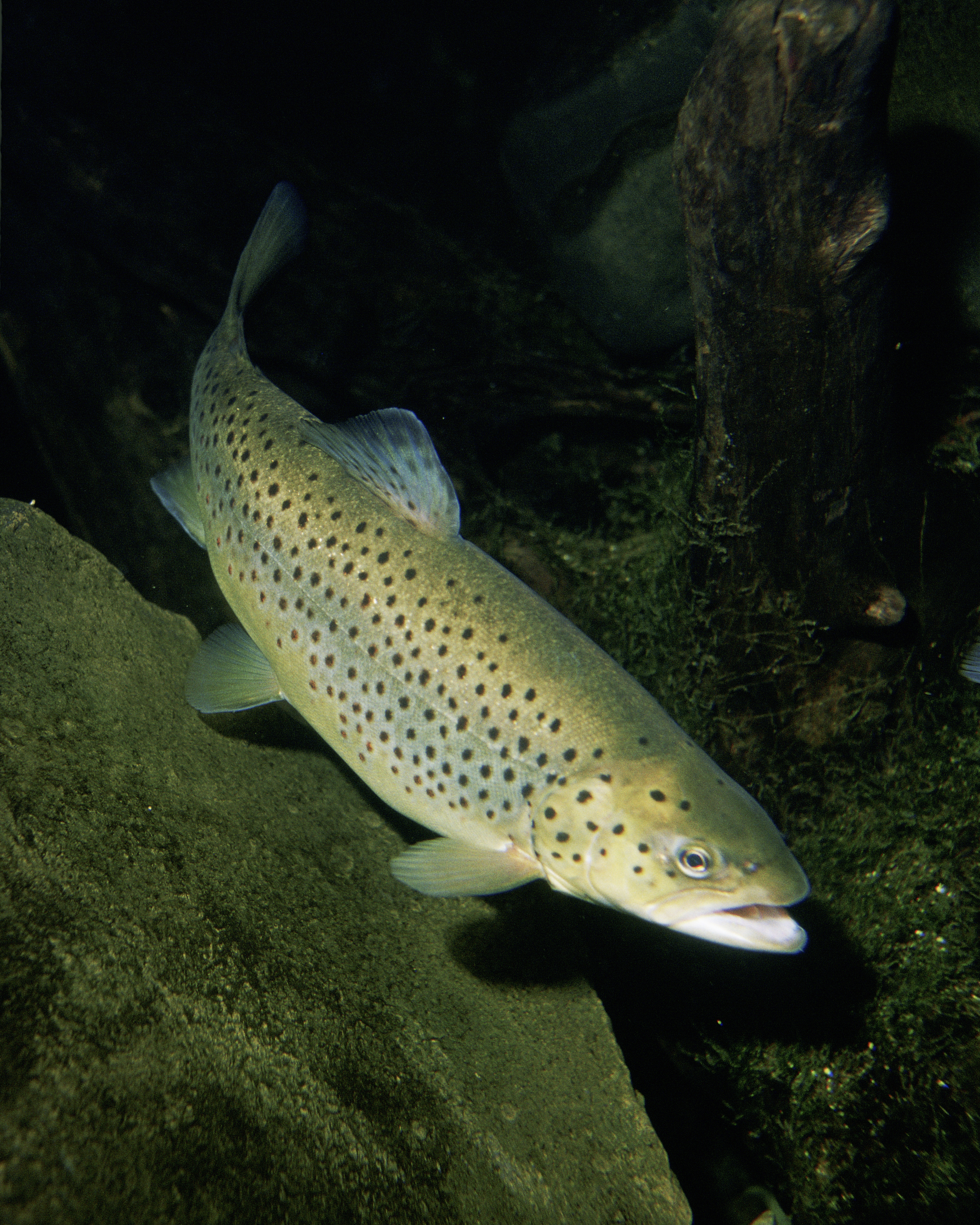|
Salvelinus
''Salvelinus'' is a genus of Salmonidae, salmonid fish often called char or charr; some species are called "trout". ''Salvelinus'' is a member of the subfamily Salmoninae within the family Salmonidae. The genus has a northern circumpolar distribution, and most of its members are typically cold-water fish that primarily inhabit fresh waters. Many species also migrate to the sea. Most char may be identified by light-cream, pink, or red spots over a darker body. Scales tend to be small, with 115–200 along the lateral line. The pectoral, pelvic, anal, and the lower aspect of caudal fins are trimmed in snow white or cream leading edges. Many members of this genus are popular sport fish, and a few, such as lake trout (''S. namaycush'') and arctic char (''S. alpinus'') are objects of commercial fisheries and/or aquaculture. Occasionally such fish escape and become invasive species. Deepwater char are small species of char living below 80 m in the deep areas of certain lakes. They ar ... [...More Info...] [...Related Items...] OR: [Wikipedia] [Google] [Baidu] |
Salvelinus Neocomensis
''Salvelinus'' is a genus of salmonid fish often called char or charr; some species are called " trout". ''Salvelinus'' is a member of the subfamily Salmoninae within the family Salmonidae. The genus has a northern circumpolar distribution, and most of its members are typically cold-water fish that primarily inhabit fresh waters. Many species also migrate to the sea. Most char may be identified by light-cream, pink, or red spots over a darker body. Scales tend to be small, with 115–200 along the lateral line. The pectoral, pelvic, anal, and the lower aspect of caudal fins are trimmed in snow white or cream leading edges. Many members of this genus are popular sport fish, and a few, such as lake trout (''S. namaycush'') and arctic char (''S. alpinus'') are objects of commercial fisheries and/or aquaculture. Occasionally such fish escape and become invasive species. Deepwater char are small species of char living below 80 m in the deep areas of certain lakes. They are hig ... [...More Info...] [...Related Items...] OR: [Wikipedia] [Google] [Baidu] |
Brook Trout
The brook trout (''Salvelinus fontinalis'') is a species of freshwater fish in the char genus ''Salvelinus'' of the salmon family Salmonidae native to Eastern North America in the United States and Canada. Two ecological forms of brook trout have been recognized by the US Forest Service. One ecological form is long-lived potamodromous populations in Lake Superior known as coaster trout or coasters. The second ecological form is the short-living predaceous anadromous populations which are found in northern lakes and coastal rivers from Long Island to Hudson Bay, which are referred to as salters. In parts of its range, it is also known as the eastern brook trout, speckled trout, brook char (or charr), squaretail, brookie, or mud trout, among others. Adult coaster brook trout are capable of reaching sizes over 2'' ''feet in length and weigh up to 6.8'' ''kg (15'' ''lb), whereas adult salters average between 6 and 15'' ''inches in length and weigh between 0. ... [...More Info...] [...Related Items...] OR: [Wikipedia] [Google] [Baidu] |
Salvelinus Alpinus
The Arctic char or Arctic charr (''Salvelinus alpinus'') is a cold-water fish in the family Salmonidae, native to alpine lakes, as well as Arctic and subarctic coastal waters in the Holarctic. Distribution and habitat It spawns in freshwater and its populations can be lacustrine, riverine, or anadromous, where they return from the ocean to their fresh water birth rivers to spawn. No other freshwater fish is found as far north; it is, for instance, the only fish species in Lake Hazen, which extends up to on Ellesmere Island in the Canadian Arctic. It is one of the rarest fish species in Great Britain and Ireland, found mainly in deep, cold, glacial lakes, and is at risk there from acidification. In other parts of its range, such as the Nordic countries, it is much more common, and is fished extensively. In Siberia, it is known as ''golets'' () and it has been introduced in lakes where it sometimes threatens less hardy endemic species, such as the small-mouth char and the ... [...More Info...] [...Related Items...] OR: [Wikipedia] [Google] [Baidu] |
Arctic Char
The Arctic char or Arctic charr (''Salvelinus alpinus'') is a cold-water fish in the family Salmonidae, native to alpine lakes, as well as Arctic and subarctic coastal waters in the Holarctic realm, Holarctic. Distribution and habitat It Spawn (biology), spawns in freshwater and its populations can be lacustrine, riverine, or anadromous, where they return from the ocean to their fresh water birth rivers to spawn. No other freshwater fish is found as far north; it is, for instance, the only fish species in Lake Hazen, which extends up to on Ellesmere Island in the Northern Canada, Canadian Arctic. It is one of the rarest fish species in Great Britain and Ireland, found mainly in deep, cold, glacial lakes, and is at risk there from acidification. In other parts of its range, such as the Nordic countries, it is much more common, and is fishery, fished extensively. In Siberia, it is known as ''golets'' () and it has been introduced in lakes where it sometimes threatens less hardy ... [...More Info...] [...Related Items...] OR: [Wikipedia] [Google] [Baidu] |
Lake Trout
The lake trout (''Salvelinus namaycush'') is a freshwater Salvelinus, char living mainly in lakes in Northern North America. Other names for it include mackinaw, namaycush, lake char (or charr), touladi, togue, laker, and grey trout. In Lake Superior, it can also be variously known as siscowet, paperbelly and lean. The lake trout is prized both as a game fish and as a Fish as food, food fish. Those caught with dark coloration may be called ''mud hens''. Taxonomy and etymology It is the only member of the subgenus ''Cristovomer'', which is more derived than the subgenus ''Salvelinus#Taxonomy, Baione'' (the most Basal (phylogenetics), basal clade of ''Salvelinus'', containing the brook trout (''S. fontinalis'') and silver trout (''S. agasizii'')) but still basal to the other members of ''Salvelinus''. The binominal nomenclature, specific epithet ''namaycush'' derives from ''namekush'', a form of the word used in some inland Southern East Cree language, Southern East Cree commun ... [...More Info...] [...Related Items...] OR: [Wikipedia] [Google] [Baidu] |
Trout
Trout (: trout) is a generic common name for numerous species of carnivorous freshwater ray-finned fishes belonging to the genera '' Oncorhynchus'', ''Salmo'' and ''Salvelinus'', all of which are members of the subfamily Salmoninae in the family Salmonidae. The word ''trout'' is also used for some similar-shaped but non-salmonid fish, such as the spotted seatrout/speckled trout (''Cynoscion nebulosus'', which is actually a croaker). Trout are closely related to salmon and have similar migratory life cycles. Most trout are strictly potamodromous, spending their entire lives exclusively in freshwater lakes, rivers and wetlands and migrating upstream to spawn in the shallow gravel beds of smaller headwater creeks. The hatched fry and juvenile trout, known as ''alevin'' and ''parr'', will stay upstream growing for years before migrating down to larger waterbodies as maturing adults. There are some anadromous species of trout, such as the steelhead (a coastal subs ... [...More Info...] [...Related Items...] OR: [Wikipedia] [Google] [Baidu] |
Silver Trout
The silver trout (''Salvelinus agassizii'') is an extinct Salvelinus, char species or subspecies that inhabited a few waters in New Hampshire in the United States prior to 1939, when a biological survey conducted on the Connecticut watershed by the New Hampshire Fish and Game Department found none. Description The silver trout was about a foot long. It had an olive-green back that faded to a bright silver underside tinged with vermillion. Females had faint golden spots along their side. Males were darker-colored with more red on the belly, and had small red spots within their golden spots. Size-based sexual dimorphism was also far more pronounced among the silver trout than among other char, with males being much larger than females, as opposed to only a slight size difference in other char species. Taxonomy The distinctiveness of the silver trout was noted by famed naturalist Louis Agassiz as far back as 1859, who requested specimens of trout from Dublin Pond, and upon analyzi ... [...More Info...] [...Related Items...] OR: [Wikipedia] [Google] [Baidu] |
Salvethymus Svetovidovi
''Salvethymus svetovidovi'', also called the long-finned charr, is a species of salmonid fish. It is endemic to Elgygytgyn Lake in Chukotka, Far East of Russia, together with two other species, the small-mouth char ''Salvelinus elgyticus'', and the Boganid char, '' Salvelinus boganidae''. Taxonomy The long-finned char is a morphologically aberrant type of char; when scientifically first described in 1990, it was placed as the single species in ''Salvethymus'', a new monotypic genus. It is closely related to the true chars in the genus ''Salvelinus'' and is phylogenetically placed within this genus; it is probably a sister lineage to the Arctic char The Arctic char or Arctic charr (''Salvelinus alpinus'') is a cold-water fish in the family Salmonidae, native to alpine lakes, as well as Arctic and subarctic coastal waters in the Holarctic realm, Holarctic. Distribution and habitat It Spaw ... (''Salvelinus alpinus'') complex. References Fish of Russia Salmonidae En ... [...More Info...] [...Related Items...] OR: [Wikipedia] [Google] [Baidu] |
Salmonidae
Salmonidae (, ) is a family (biology), family of ray-finned fish, the only extant member of the suborder Salmonoidei, consisting of 11 extant genera and over 200 species collectively known as "salmonids" or "salmonoids". The family includes salmon (both Atlantic and Pacific species), trout (both ocean-going and landlocked), Salvelinus, char, Thymallus, graylings, freshwater whitefishes, taimens and lenoks, all coldwater fish, coldwater mid-trophic level, level predatory fish that inhabit the subarctic and cool temperate waters of the Northern Hemisphere. The Atlantic salmon (''Salmo salar''), whose Latin name became that of its genus ''Salmo'', is also the eponym of the family and order names. Salmonids have a relatively primitive appearance among teleost fish, with the pelvic fins being placed far back, and an adipose fin towards the rear of the back. They have slender bodies with rounded fish scale, scales and forked caudal fin, tail fins, and their fish jaw, mouths contain a si ... [...More Info...] [...Related Items...] OR: [Wikipedia] [Google] [Baidu] |
Fish
A fish (: fish or fishes) is an aquatic animal, aquatic, Anamniotes, anamniotic, gill-bearing vertebrate animal with swimming fish fin, fins and craniate, a hard skull, but lacking limb (anatomy), limbs with digit (anatomy), digits. Fish can be grouped into the more basal (phylogenetics), basal jawless fish and the more common jawed fish, the latter including all extant taxon, living cartilaginous fish, cartilaginous and bony fish, as well as the extinct placoderms and acanthodians. In a break to the long tradition of grouping all fish into a single Class (biology), class (Pisces), modern phylogenetics views fish as a paraphyletic group. Most fish are ectotherm, cold-blooded, their body temperature varying with the surrounding water, though some large nekton, active swimmers like white shark and tuna can hold a higher core temperature. Many fish can communication in aquatic animals#Acoustic, communicate acoustically with each other, such as during courtship displays. The stud ... [...More Info...] [...Related Items...] OR: [Wikipedia] [Google] [Baidu] |
Invasive Species
An invasive species is an introduced species that harms its new environment. Invasive species adversely affect habitats and bioregions, causing ecological, environmental, and/or economic damage. The term can also be used for native species that become harmful to their native environment after human alterations to its food web. Since the 20th century, invasive species have become serious economic, social, and environmental threats worldwide. Invasion of long-established ecosystems by organisms is a natural phenomenon, but human-facilitated introductions have greatly increased the rate, scale, and geographic range of invasion. For millennia, humans have served as both accidental and deliberate dispersal agents, beginning with their earliest migrations, accelerating in the Age of Discovery, and accelerating again with the spread of international trade. Notable invasive plant species include the kudzu vine, giant hogweed (''Heracleum mantegazzianum''), Japanese knotw ... [...More Info...] [...Related Items...] OR: [Wikipedia] [Google] [Baidu] |










